GROUP F – ENGINE ATA-chapter 71 / POWER

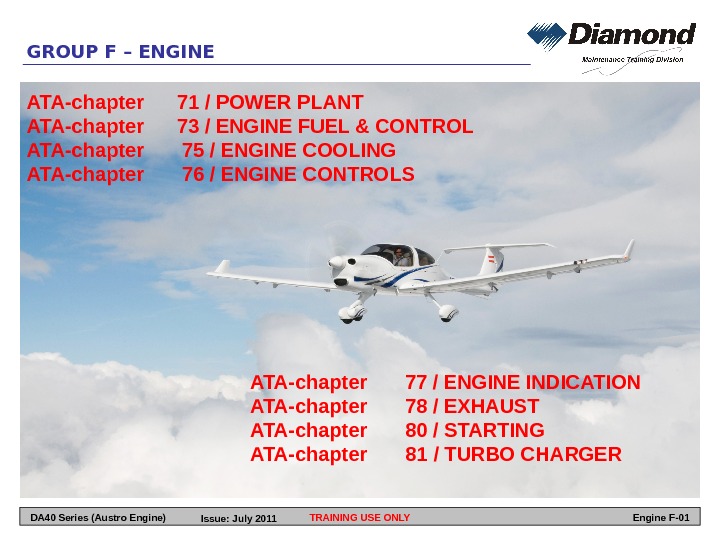
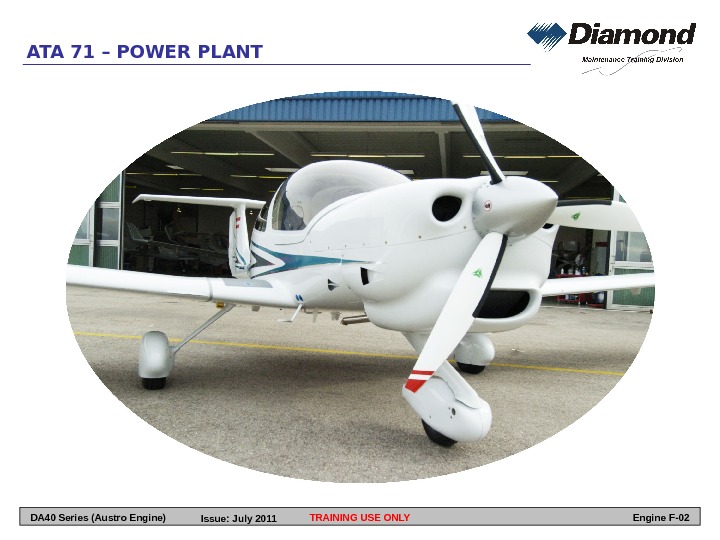

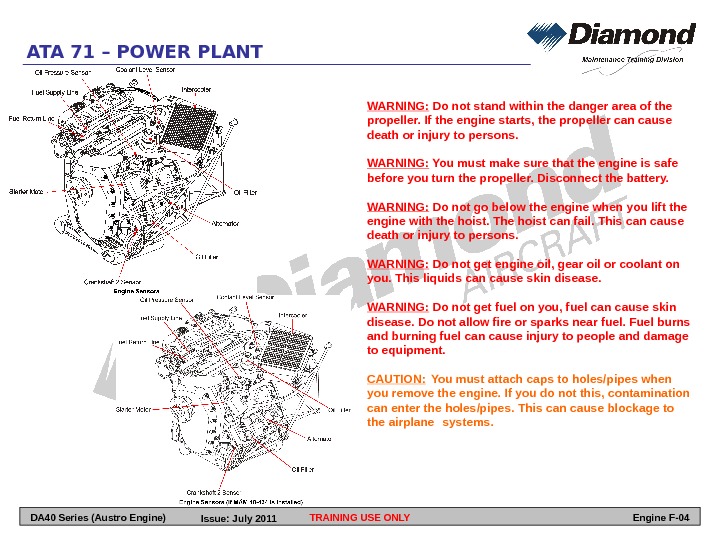
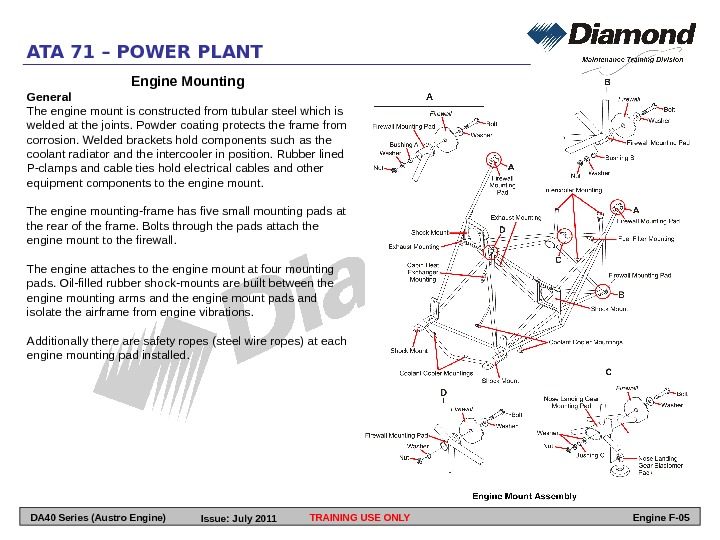
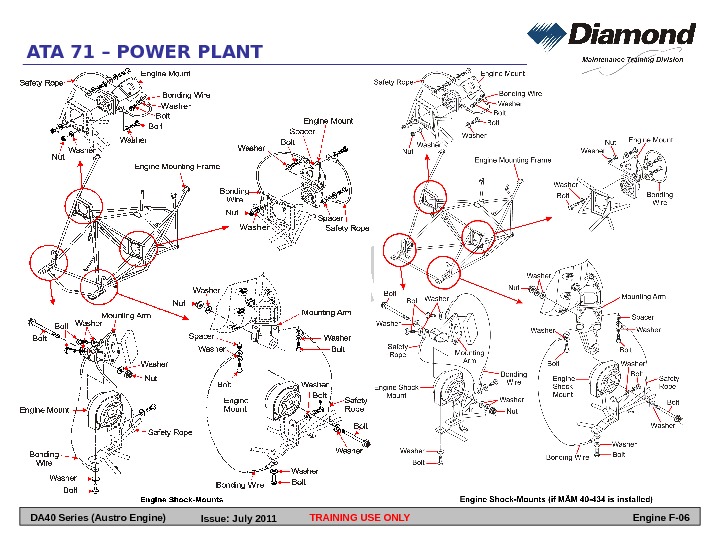
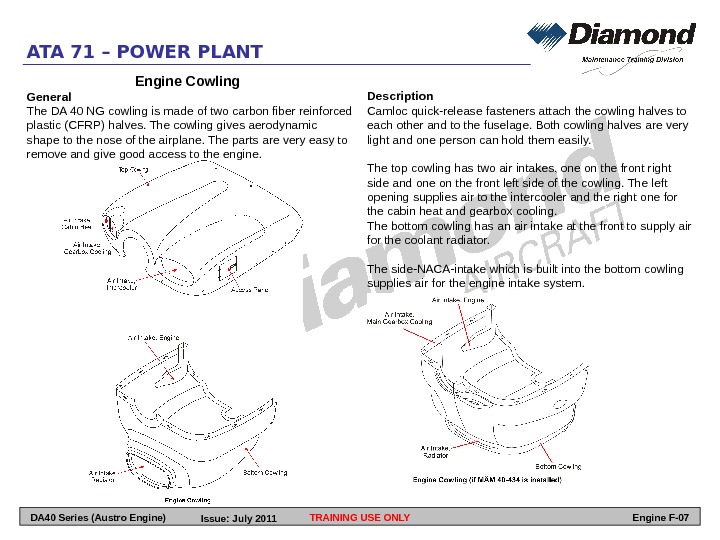
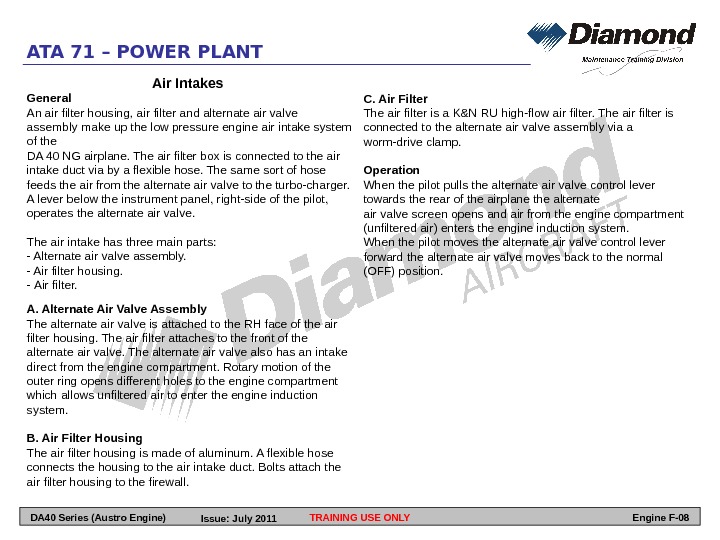
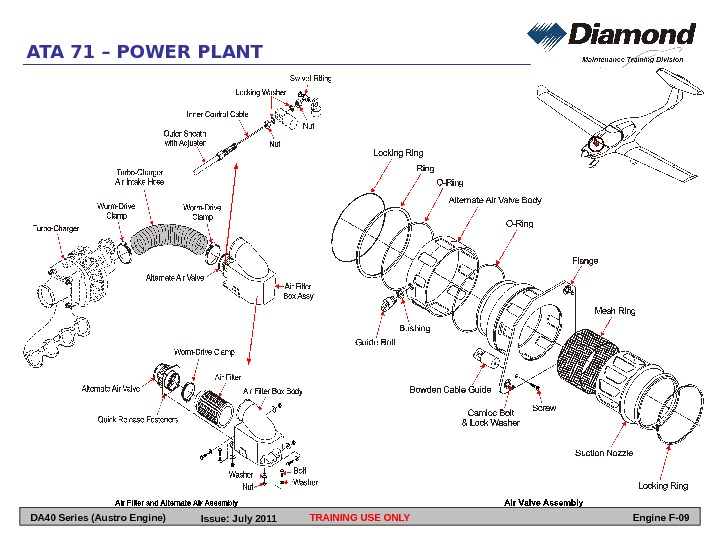
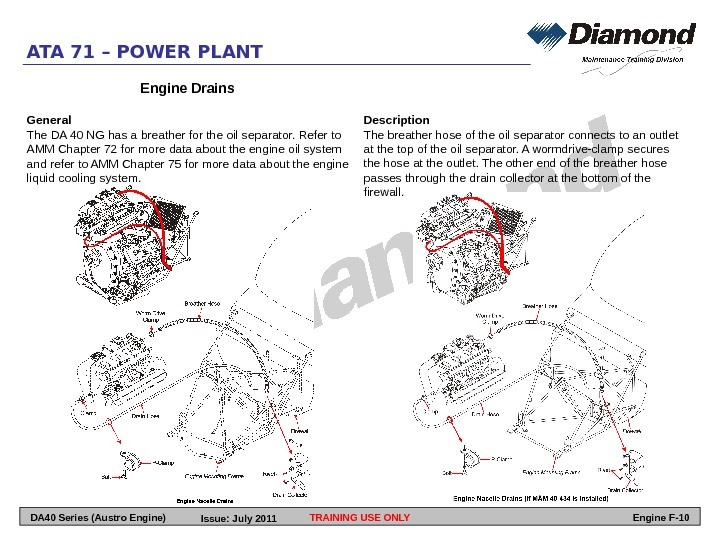




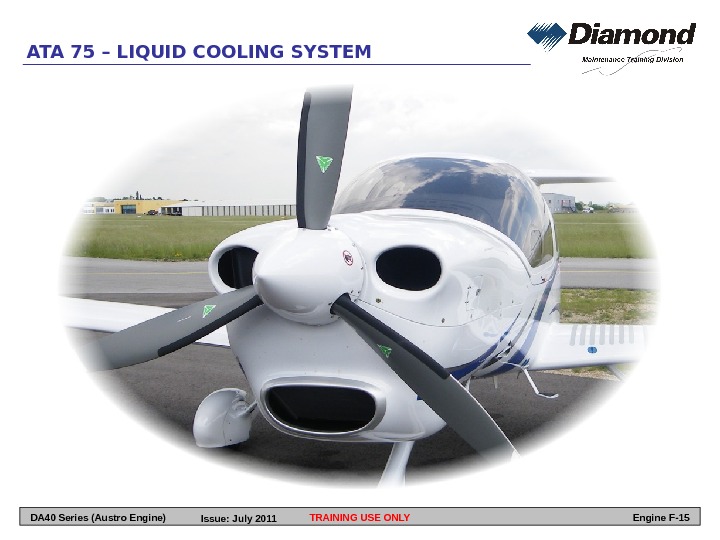
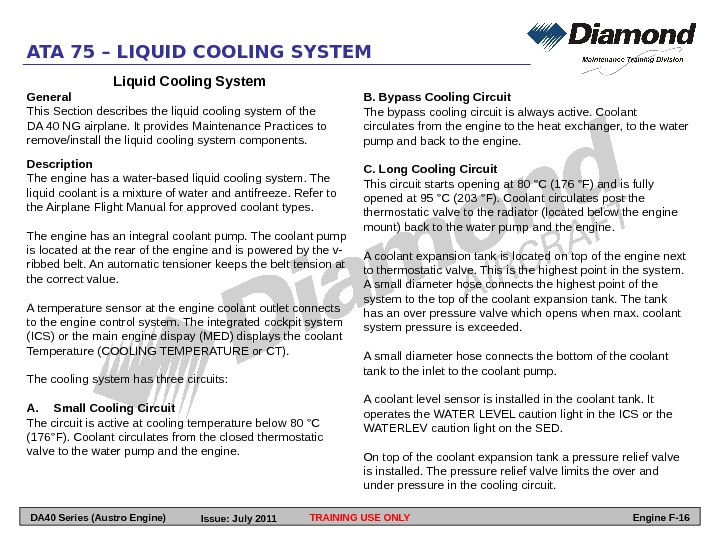
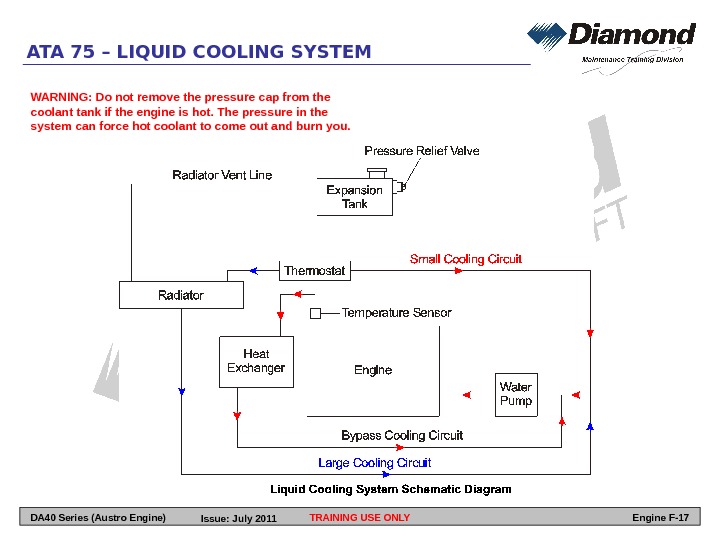
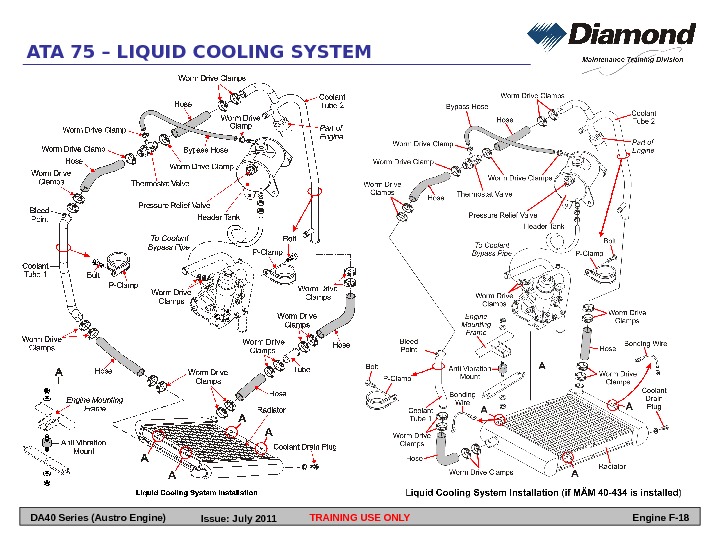
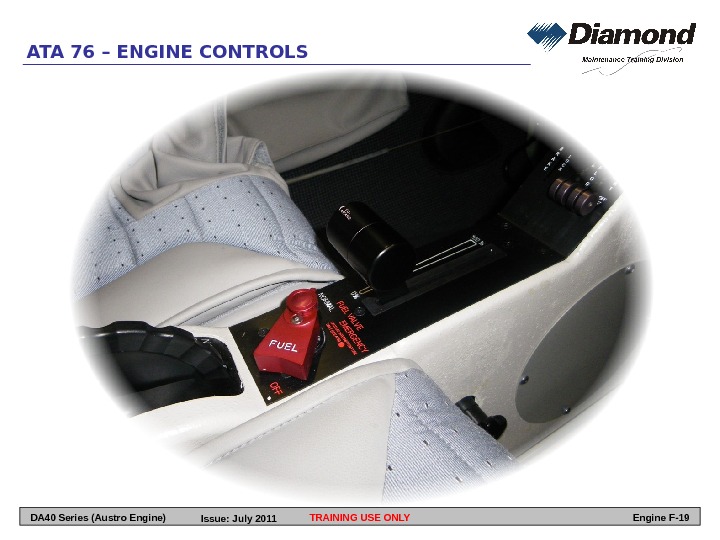
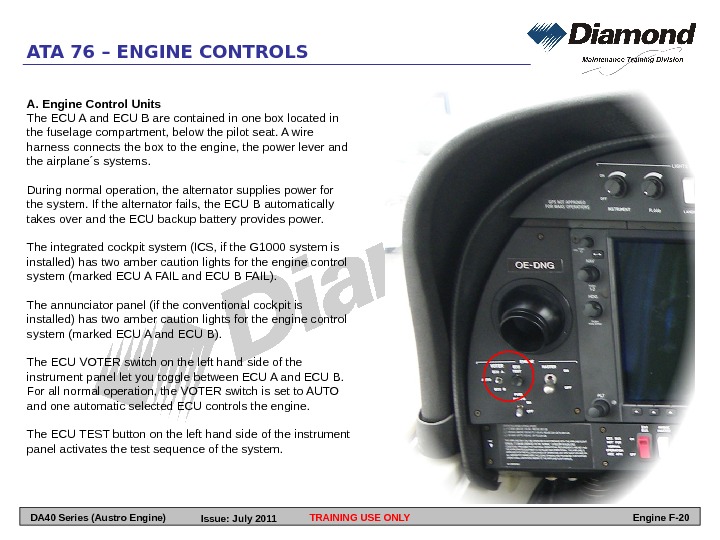
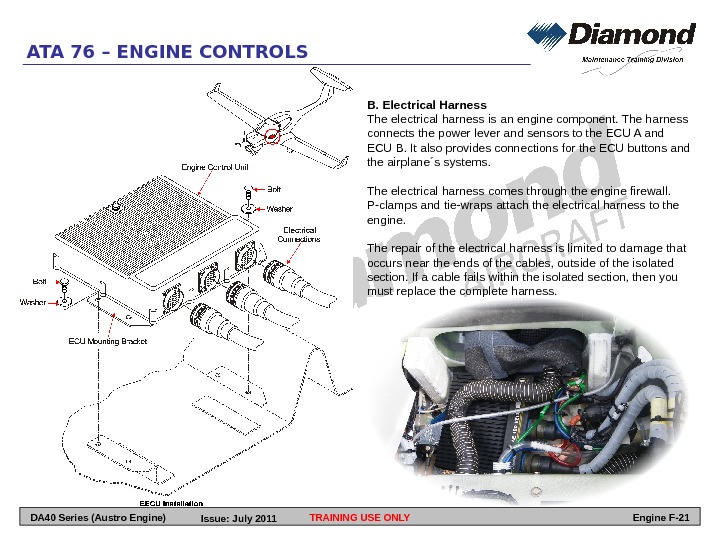
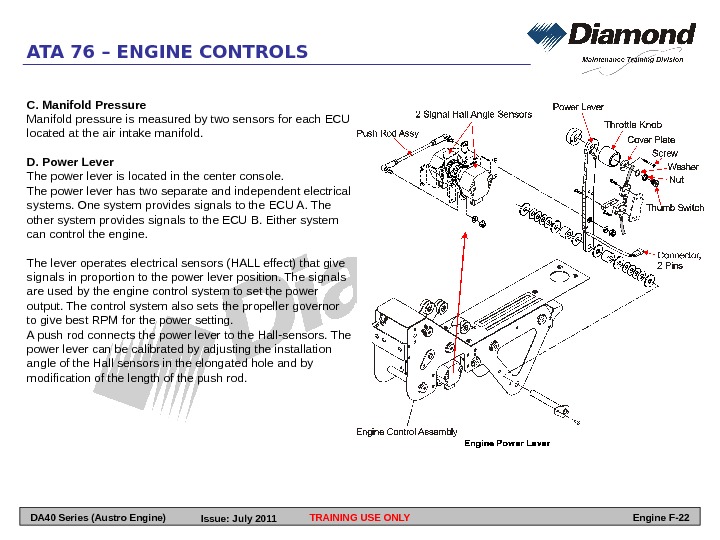
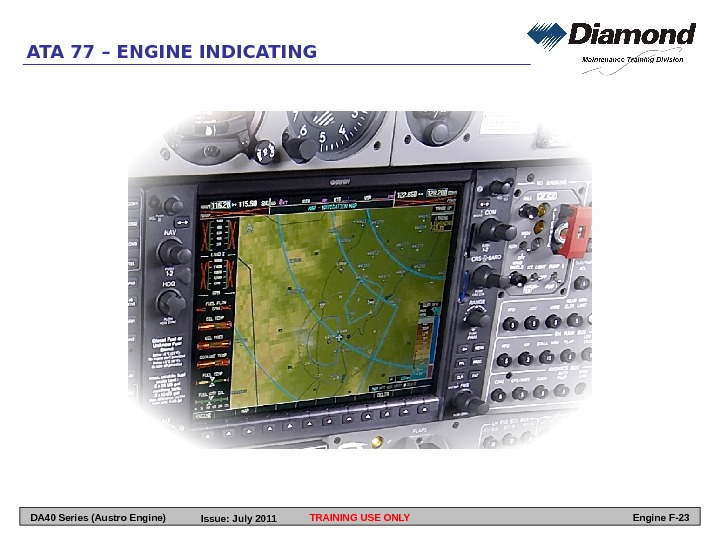

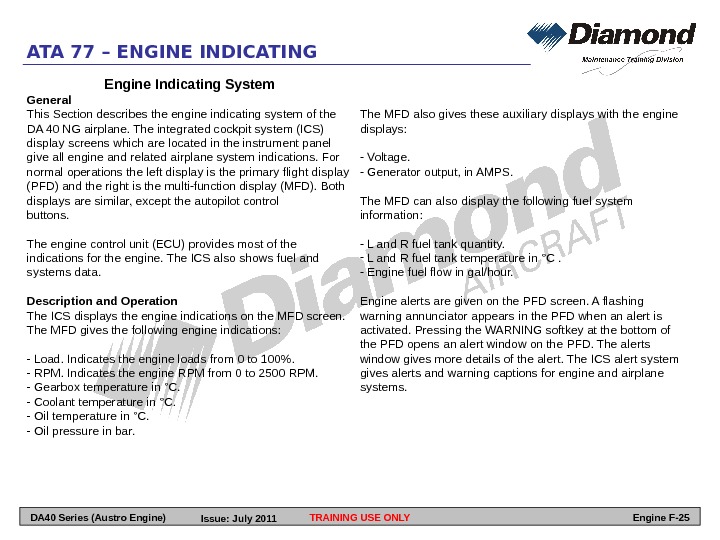
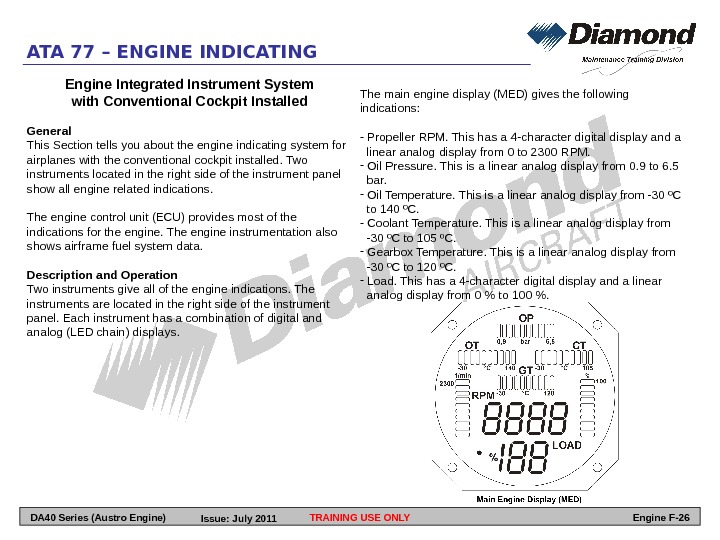
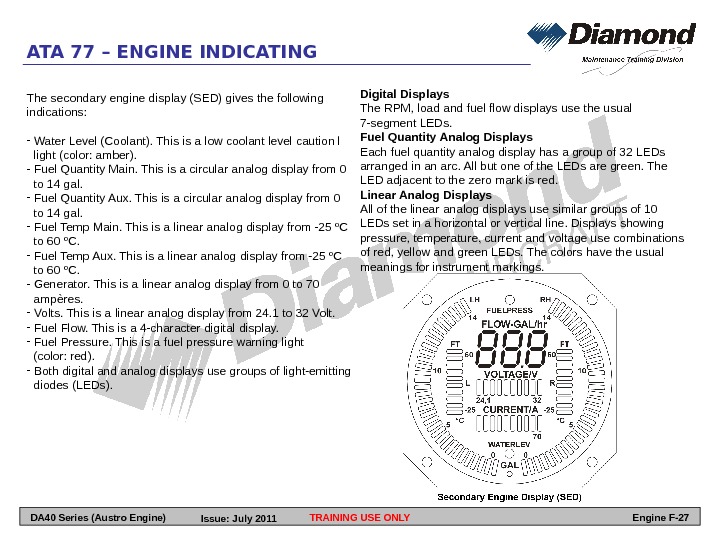
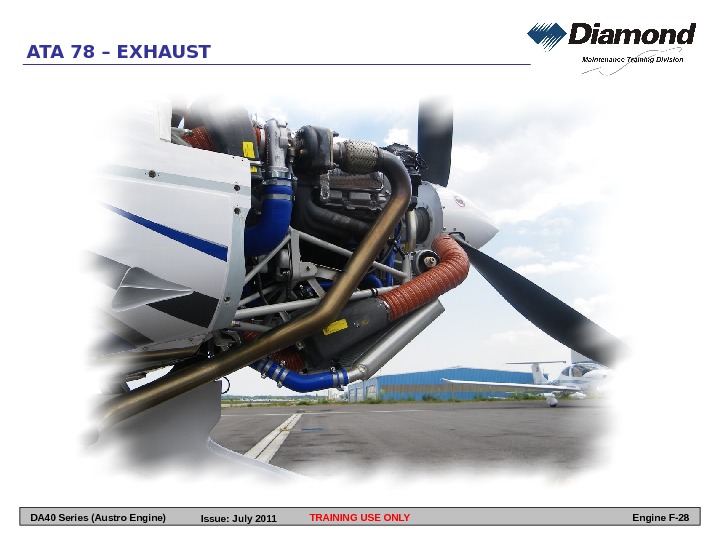
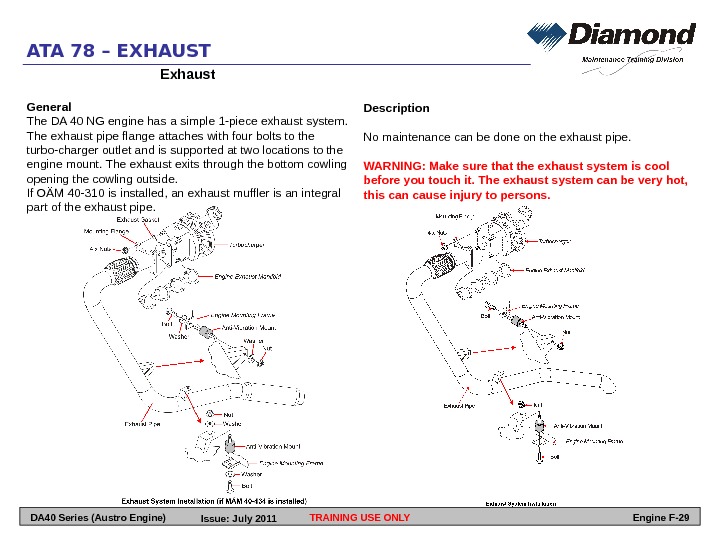

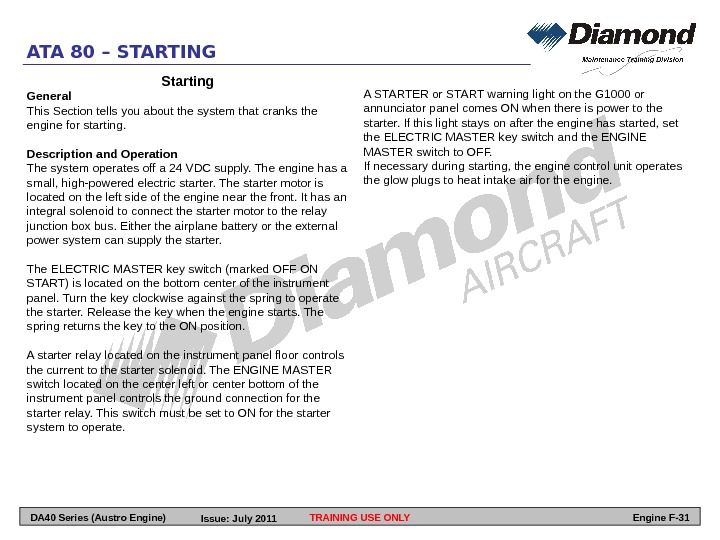
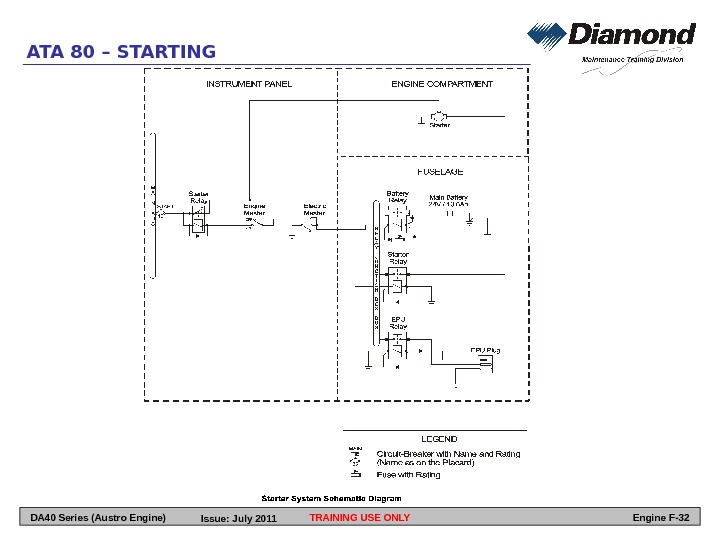
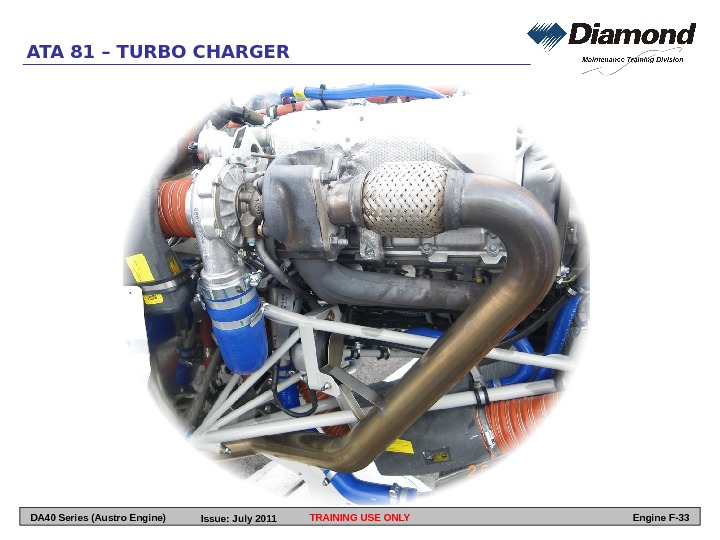
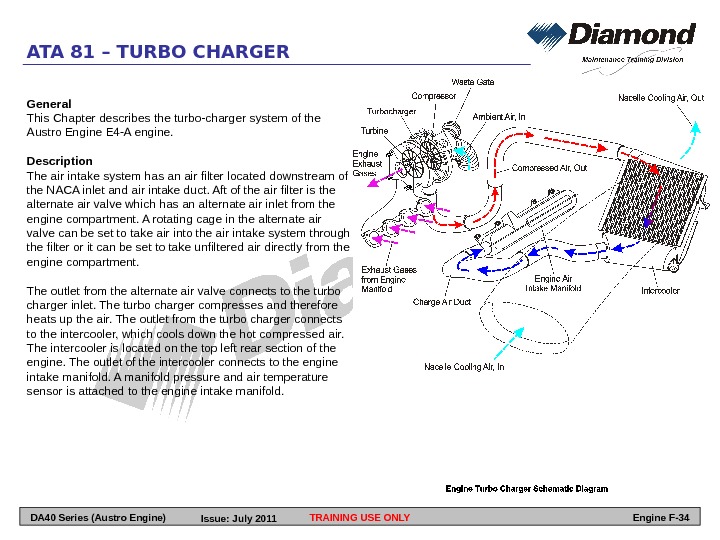
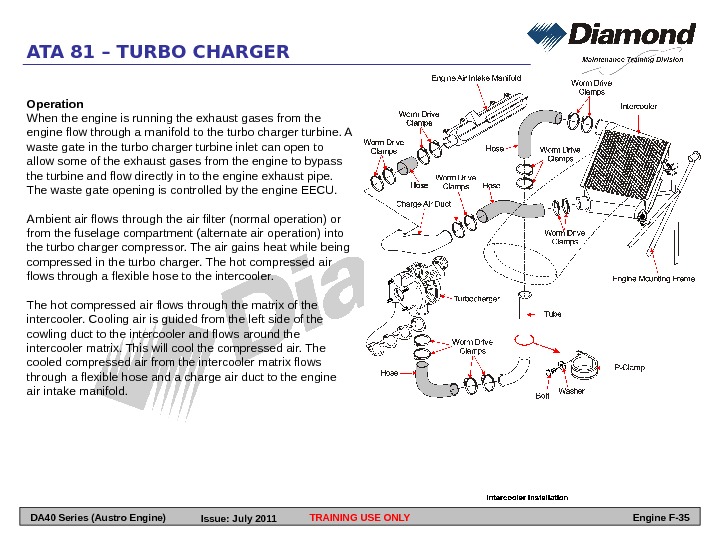
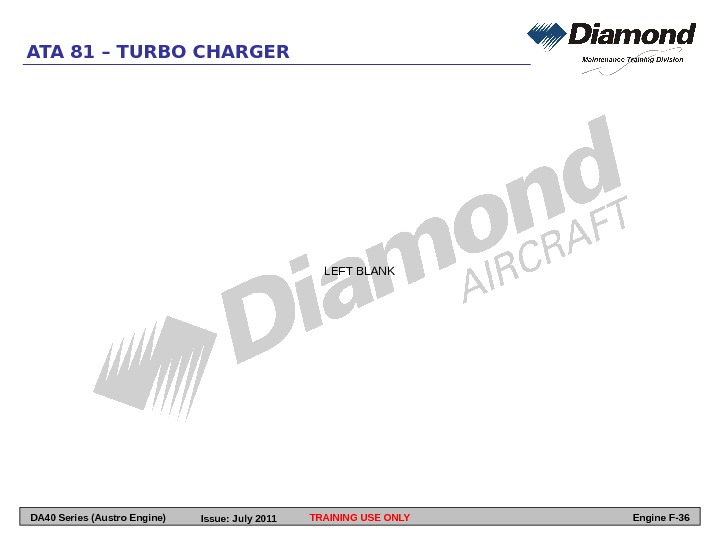
- Размер: 10.5 Mегабайта
- Количество слайдов: 36
Описание презентации GROUP F – ENGINE ATA-chapter 71 / POWER по слайдам
 GROUP F – ENGINE ATA-chapter 71 / POWER PLANT ATA-chapter 73 / ENGINE FUEL & CONTROL ATA-chapter 75 / ENGINE COOLING ATA-chapter 76 / ENGINE CONTROLS ATA-chapter 77 / ENGINE INDICATION ATA-chapter 78 / EXHAUST ATA-chapter 80 / STARTING ATA-chapter 81 / TURBO CHARGER TRAINING USE ONLYDA 40 Series (Austro Engine) Engine F-01 Issue: July
GROUP F – ENGINE ATA-chapter 71 / POWER PLANT ATA-chapter 73 / ENGINE FUEL & CONTROL ATA-chapter 75 / ENGINE COOLING ATA-chapter 76 / ENGINE CONTROLS ATA-chapter 77 / ENGINE INDICATION ATA-chapter 78 / EXHAUST ATA-chapter 80 / STARTING ATA-chapter 81 / TURBO CHARGER TRAINING USE ONLYDA 40 Series (Austro Engine) Engine F-01 Issue: July
 ATA 71 – POWER PLANT TRAINING USE ONLY Engine F-02 DA 40 Series (Austro Engine) Issue: July
ATA 71 – POWER PLANT TRAINING USE ONLY Engine F-02 DA 40 Series (Austro Engine) Issue: July
 ATA 71 – POWER PLANT (AE 4 -A) Refer to the DA 40 NG Airplane Flight Manual for engine start/stop procedures. For particular information on the firmware refer to applicable DAI Service Bulletin. Refer to these Chapters for data about other engine systems: — Chapter 72 Engine. Refer to the AE Operation Manual, latest revision for data on the engine. — Chapter 73 Engine fuel and control. Refer to the AE Operation Manual, latest revision for data on the fuel injection system. — Chapter 76 Engine controls. — Chapter 77 Engine indicating. — Chapter 78 Exhaust system. — Chapter 79 Oil system. Refer to the AE Operation Manual, latest revision for data on the engine oil system. -Chapter 80 Starter system control and installation. Refer to the AE Operation Manual, latest revision for data on the starter. — Chapter 81 Turbo charger. General This Chapter describes the power plant removal and installation of the DA 40 NG. For data on conducting an engine test after installation refer to the Operation Manual for the E 4 -A engine. TRAINING USE ONLY Engine F-03 DA 40 Series (Austro Engine) Issue: July
ATA 71 – POWER PLANT (AE 4 -A) Refer to the DA 40 NG Airplane Flight Manual for engine start/stop procedures. For particular information on the firmware refer to applicable DAI Service Bulletin. Refer to these Chapters for data about other engine systems: — Chapter 72 Engine. Refer to the AE Operation Manual, latest revision for data on the engine. — Chapter 73 Engine fuel and control. Refer to the AE Operation Manual, latest revision for data on the fuel injection system. — Chapter 76 Engine controls. — Chapter 77 Engine indicating. — Chapter 78 Exhaust system. — Chapter 79 Oil system. Refer to the AE Operation Manual, latest revision for data on the engine oil system. -Chapter 80 Starter system control and installation. Refer to the AE Operation Manual, latest revision for data on the starter. — Chapter 81 Turbo charger. General This Chapter describes the power plant removal and installation of the DA 40 NG. For data on conducting an engine test after installation refer to the Operation Manual for the E 4 -A engine. TRAINING USE ONLY Engine F-03 DA 40 Series (Austro Engine) Issue: July
 WARNING: Do not stand within the danger area of the propeller. If the engine starts, the propeller can cause death or injury to persons. WARNING: You must make sure that the engine is safe before you turn the propeller. Disconnect the battery. WARNING: Do not go below the engine when you lift the engine with the hoist. The hoist can fail. This can cause death or injury to persons. WARNING: Do not get engine oil, gear oil or coolant on you. This liquids can cause skin disease. WARNING: Do not get fuel on you, fuel can cause skin disease. Do not allow fire or sparks near fuel. Fuel burns and burning fuel can cause injury to people and damage to equipment. CAUTION: You must attach caps to holes/pipes when you remove the engine. If you do not this, contamination can enter the holes/pipes. This can cause blockage to the airplane systems. ATA 71 – POWER PLANT TRAINING USE ONLY Engine F-04 DA 40 Series (Austro Engine) Issue: July
WARNING: Do not stand within the danger area of the propeller. If the engine starts, the propeller can cause death or injury to persons. WARNING: You must make sure that the engine is safe before you turn the propeller. Disconnect the battery. WARNING: Do not go below the engine when you lift the engine with the hoist. The hoist can fail. This can cause death or injury to persons. WARNING: Do not get engine oil, gear oil or coolant on you. This liquids can cause skin disease. WARNING: Do not get fuel on you, fuel can cause skin disease. Do not allow fire or sparks near fuel. Fuel burns and burning fuel can cause injury to people and damage to equipment. CAUTION: You must attach caps to holes/pipes when you remove the engine. If you do not this, contamination can enter the holes/pipes. This can cause blockage to the airplane systems. ATA 71 – POWER PLANT TRAINING USE ONLY Engine F-04 DA 40 Series (Austro Engine) Issue: July
 Engine Mounting General The engine mount is constructed from tubular steel which is welded at the joints. Powder coating protects the frame from corrosion. Welded brackets hold components such as the coolant radiator and the intercooler in position. Rubber lined P-clamps and cable ties hold electrical cables and other equipment components to the engine mount. The engine mounting-frame has five small mounting pads at the rear of the frame. Bolts through the pads attach the engine mount to the firewall. The engine attaches to the engine mount at four mounting pads. Oil-filled rubber shock-mounts are built between the engine mounting arms and the engine mount pads and isolate the airframe from engine vibrations. Additionally there are safety ropes (steel wire ropes) at each engine mounting pad installed. ATA 71 – POWER PLANT TRAINING USE ONLY Engine F-05 DA 40 Series (Austro Engine) Issue: July
Engine Mounting General The engine mount is constructed from tubular steel which is welded at the joints. Powder coating protects the frame from corrosion. Welded brackets hold components such as the coolant radiator and the intercooler in position. Rubber lined P-clamps and cable ties hold electrical cables and other equipment components to the engine mount. The engine mounting-frame has five small mounting pads at the rear of the frame. Bolts through the pads attach the engine mount to the firewall. The engine attaches to the engine mount at four mounting pads. Oil-filled rubber shock-mounts are built between the engine mounting arms and the engine mount pads and isolate the airframe from engine vibrations. Additionally there are safety ropes (steel wire ropes) at each engine mounting pad installed. ATA 71 – POWER PLANT TRAINING USE ONLY Engine F-05 DA 40 Series (Austro Engine) Issue: July
 ATA 71 – POWER PLANT TRAINING USE ONLY Engine F-06 DA 40 Series (Austro Engine) Issue: July
ATA 71 – POWER PLANT TRAINING USE ONLY Engine F-06 DA 40 Series (Austro Engine) Issue: July
 Engine Cowling General The DA 40 NG cowling is made of two carbon fiber reinforced plastic (CFRP) halves. The cowling gives aerodynamic shape to the nose of the airplane. The parts are very easy to remove and give good access to the engine. ATA 71 – POWER PLANT TRAINING USE ONLY Engine F-07 DA 40 Series (Austro Engine) Description Camloc quick-release fasteners attach the cowling halves to each other and to the fuselage. Both cowling halves are very light and one person can hold them easily. The top cowling has two air intakes, one on the front right side and one on the front left side of the cowling. The left opening supplies air to the intercooler and the right one for the cabin heat and gearbox cooling. The bottom cowling has an air intake at the front to supply air for the coolant radiator. The side-NACA-intake which is built into the bottom cowling supplies air for the engine intake system. Issue: July
Engine Cowling General The DA 40 NG cowling is made of two carbon fiber reinforced plastic (CFRP) halves. The cowling gives aerodynamic shape to the nose of the airplane. The parts are very easy to remove and give good access to the engine. ATA 71 – POWER PLANT TRAINING USE ONLY Engine F-07 DA 40 Series (Austro Engine) Description Camloc quick-release fasteners attach the cowling halves to each other and to the fuselage. Both cowling halves are very light and one person can hold them easily. The top cowling has two air intakes, one on the front right side and one on the front left side of the cowling. The left opening supplies air to the intercooler and the right one for the cabin heat and gearbox cooling. The bottom cowling has an air intake at the front to supply air for the coolant radiator. The side-NACA-intake which is built into the bottom cowling supplies air for the engine intake system. Issue: July
 Air Intakes General An air filter housing, air filter and alternate air valve assembly make up the low pressure engine air intake system of the DA 40 NG airplane. The air filter box is connected to the air intake duct via by a flexible hose. The same sort of hose feeds the air from the alternate air valve to the turbo-charger. A lever below the instrument panel, right-side of the pilot, operates the alternate air valve. The air intake has three main parts: — Alternate air valve assembly. — Air filter housing. — Air filter. A. Alternate Air Valve Assembly The alternate air valve is attached to the RH face of the air filter housing. The air filter attaches to the front of the alternate air valve. The alternate air valve also has an intake direct from the engine compartment. Rotary motion of the outer ring opens different holes to the engine compartment which allows unfiltered air to enter the engine induction system. B. Air Filter Housing The air filter housing is made of aluminum. A flexible hose connects the housing to the air intake duct. Bolts attach the air filter housing to the firewall. ATA 71 – POWER PLANT C. Air Filter The air filter is a K&N RU high-flow air filter. The air filter is connected to the alternate air valve assembly via a worm-drive clamp. Operation When the pilot pulls the alternate air valve control lever towards the rear of the airplane the alternate air valve screen opens and air from the engine compartment (unfiltered air) enters the engine induction system. When the pilot moves the alternate air valve control lever forward the alternate air valve moves back to the normal (OFF) position. TRAINING USE ONLY Engine F-08 DA 40 Series (Austro Engine) Issue: July
Air Intakes General An air filter housing, air filter and alternate air valve assembly make up the low pressure engine air intake system of the DA 40 NG airplane. The air filter box is connected to the air intake duct via by a flexible hose. The same sort of hose feeds the air from the alternate air valve to the turbo-charger. A lever below the instrument panel, right-side of the pilot, operates the alternate air valve. The air intake has three main parts: — Alternate air valve assembly. — Air filter housing. — Air filter. A. Alternate Air Valve Assembly The alternate air valve is attached to the RH face of the air filter housing. The air filter attaches to the front of the alternate air valve. The alternate air valve also has an intake direct from the engine compartment. Rotary motion of the outer ring opens different holes to the engine compartment which allows unfiltered air to enter the engine induction system. B. Air Filter Housing The air filter housing is made of aluminum. A flexible hose connects the housing to the air intake duct. Bolts attach the air filter housing to the firewall. ATA 71 – POWER PLANT C. Air Filter The air filter is a K&N RU high-flow air filter. The air filter is connected to the alternate air valve assembly via a worm-drive clamp. Operation When the pilot pulls the alternate air valve control lever towards the rear of the airplane the alternate air valve screen opens and air from the engine compartment (unfiltered air) enters the engine induction system. When the pilot moves the alternate air valve control lever forward the alternate air valve moves back to the normal (OFF) position. TRAINING USE ONLY Engine F-08 DA 40 Series (Austro Engine) Issue: July
 ATA 71 – POWER PLANT TRAINING USE ONLY Engine F-09 DA 40 Series (Austro Engine) Issue: July
ATA 71 – POWER PLANT TRAINING USE ONLY Engine F-09 DA 40 Series (Austro Engine) Issue: July
 Engine Drains General The DA 40 NG has a breather for the oil separator. Refer to AMM Chapter 72 for more data about the engine oil system and refer to AMM Chapter 75 for more data about the engine liquid cooling system. ATA 71 – POWER PLANT TRAINING USE ONLY Engine F-10 DA 40 Series (Austro Engine) Description The breather hose of the oil separator connects to an outlet at the top of the oil separator. A wormdrive-clamp secures the hose at the outlet. The other end of the breather hose passes through the drain collector at the bottom of the firewall. Issue: July
Engine Drains General The DA 40 NG has a breather for the oil separator. Refer to AMM Chapter 72 for more data about the engine oil system and refer to AMM Chapter 75 for more data about the engine liquid cooling system. ATA 71 – POWER PLANT TRAINING USE ONLY Engine F-10 DA 40 Series (Austro Engine) Description The breather hose of the oil separator connects to an outlet at the top of the oil separator. A wormdrive-clamp secures the hose at the outlet. The other end of the breather hose passes through the drain collector at the bottom of the firewall. Issue: July
 ATA 73 – ENGINE FUEL AND CONTROL TRAINING USE ONLY Engine F-11 DA 40 Series (Austro Engine) Issue: July
ATA 73 – ENGINE FUEL AND CONTROL TRAINING USE ONLY Engine F-11 DA 40 Series (Austro Engine) Issue: July
 ATA 73 – ENGINE FUEL AND CONTROL Engine Fuel and Control General This Section describes the fuel system of the Austro Engine E 4 -A engine and provides general data and trouble shooting information of the system. Refer also to the engine manufacturer’s Repair Manual for the Austro Engine E 4 -A engine. You can replace components in the air intake system and the fuel filter. Refer to the engine manufacturer for data on the engine fuel system. Description and Operation The power generation system has two main parts: — Air intake system. This system supplies air from the inlet to the air filter to the engine intake manifold. — Engine fuel system. The engine fuel system takes fuel from the airplane fuel system and injects it into the cylinders. TRAINING USE ONLY Engine F-12 DA 40 Series (Austro Engine) Issue: July
ATA 73 – ENGINE FUEL AND CONTROL Engine Fuel and Control General This Section describes the fuel system of the Austro Engine E 4 -A engine and provides general data and trouble shooting information of the system. Refer also to the engine manufacturer’s Repair Manual for the Austro Engine E 4 -A engine. You can replace components in the air intake system and the fuel filter. Refer to the engine manufacturer for data on the engine fuel system. Description and Operation The power generation system has two main parts: — Air intake system. This system supplies air from the inlet to the air filter to the engine intake manifold. — Engine fuel system. The engine fuel system takes fuel from the airplane fuel system and injects it into the cylinders. TRAINING USE ONLY Engine F-12 DA 40 Series (Austro Engine) Issue: July
 ATA 73 – ENGINE FUEL AND CONTROL A. Air Intake System The air intake system has an air filter which is located at the firewall in the engine compartment. The filter attaches to the forward face of the alternate air valve. The alternate air valve inlet takes air direct from the engine compartment. The valve can be selected to provide filtered air or warm, unfiltered air to the engine. The outlet of the alternate air valve connects to the turbo charger. The outlet of the turbo-charger connects then to an intercooler and the engine intake manifold. Refer to AMM Chapter 81 for more data on the turbo charger and intercooler. B. Engine Fuel System The fuel from the main tank flows through the fuel selector, gascolator (filter size 210 μm) to the electrically driven low pressure fuel pumps. These fuel pumps supply the high pressure pump with the required fuel pressure and flow. A fine fuel filter is installed upstream of the high pressure pump to assure clean fuel supply. Located between the fine fuel filter and the high pressure fuel pump is a damper to reduce the fuel pressure pulsations. The high-pressure pump supplies fuel to a common rail connected to the injectors. A fuel metering unit at the engine driven high pressure fuel pump which ensures that only the required quantity of fuel is compressed. The necessary rail pressure, which is measured directly at the rail, is controlled by the rail pressure valve. Surplus fuel returns to the airplane main fuel system. The fuel returning from the engine is hot. The hot fuel passes through a fuel cooler located in the fuselage wing attachment area. From there the fuel returns via a cooling loop through the auxiliary tank to the fuel main tank. TRAINING USE ONLY Engine F-13 DA 40 Series (Austro Engine) Issue: July
ATA 73 – ENGINE FUEL AND CONTROL A. Air Intake System The air intake system has an air filter which is located at the firewall in the engine compartment. The filter attaches to the forward face of the alternate air valve. The alternate air valve inlet takes air direct from the engine compartment. The valve can be selected to provide filtered air or warm, unfiltered air to the engine. The outlet of the alternate air valve connects to the turbo charger. The outlet of the turbo-charger connects then to an intercooler and the engine intake manifold. Refer to AMM Chapter 81 for more data on the turbo charger and intercooler. B. Engine Fuel System The fuel from the main tank flows through the fuel selector, gascolator (filter size 210 μm) to the electrically driven low pressure fuel pumps. These fuel pumps supply the high pressure pump with the required fuel pressure and flow. A fine fuel filter is installed upstream of the high pressure pump to assure clean fuel supply. Located between the fine fuel filter and the high pressure fuel pump is a damper to reduce the fuel pressure pulsations. The high-pressure pump supplies fuel to a common rail connected to the injectors. A fuel metering unit at the engine driven high pressure fuel pump which ensures that only the required quantity of fuel is compressed. The necessary rail pressure, which is measured directly at the rail, is controlled by the rail pressure valve. Surplus fuel returns to the airplane main fuel system. The fuel returning from the engine is hot. The hot fuel passes through a fuel cooler located in the fuselage wing attachment area. From there the fuel returns via a cooling loop through the auxiliary tank to the fuel main tank. TRAINING USE ONLY Engine F-13 DA 40 Series (Austro Engine) Issue: July
 LEFT BLANK TRAINING USE ONLY Engine F-14 DA 40 Series (Austro Engine)ATA 73 – ENGINE FUEL AND CONTROL Issue: July
LEFT BLANK TRAINING USE ONLY Engine F-14 DA 40 Series (Austro Engine)ATA 73 – ENGINE FUEL AND CONTROL Issue: July
 ATA 75 – LIQUID COOLING SYSTEM TRAINING USE ONLY Engine F-15 DA 40 Series (Austro Engine) Issue: July
ATA 75 – LIQUID COOLING SYSTEM TRAINING USE ONLY Engine F-15 DA 40 Series (Austro Engine) Issue: July
 Liquid Cooling System General This Section describes the liquid cooling system of the DA 40 NG airplane. It provides Maintenance Practices to remove/install the liquid cooling system components. Description The engine has a water-based liquid cooling system. The liquid coolant is a mixture of water and antifreeze. Refer to the Airplane Flight Manual for approved coolant types. The engine has an integral coolant pump. The coolant pump is located at the rear of the engine and is powered by the v- ribbed belt. An automatic tensioner keeps the belt tension at the correct value. A temperature sensor at the engine coolant outlet connects to the engine control system. The integrated cockpit system (ICS) or the main engine dispay (MED) displays the coolant Temperature (COOLING TEMPERATURE or CT). The cooling system has three circuits: A. Small Cooling Circuit The circuit is active at cooling temperature below 80 °C (176°F). Coolant circulates from the closed thermostatic valve to the water pump and the engine. B. Bypass Cooling Circuit The bypass cooling circuit is always active. Coolant circulates from the engine to the heat exchanger, to the water pump and back to the engine. C. Long Cooling Circuit This circuit starts opening at 80 °C (176 °F) and is fully opened at 95 °C (203 °F). Coolant circulates post thermostatic valve to the radiator (located below the engine mount) back to the water pump and the engine. A coolant expansion tank is located on top of the engine next to thermostatic valve. This is the highest point in the system. A small diameter hose connects the highest point of the system to the top of the coolant expansion tank. The tank has an over pressure valve which opens when max. coolant system pressure is exceeded. A small diameter hose connects the bottom of the coolant tank to the inlet to the coolant pump. A coolant level sensor is installed in the coolant tank. It operates the WATER LEVEL caution light in the ICS or the WATERLEV caution light on the SED. On top of the coolant expansion tank a pressure relief valve is installed. The pressure relief valve limits the over and under pressure in the cooling circuit. TRAINING USE ONLY Engine F-16 DA 40 Series (Austro Engine)ATA 75 – LIQUID COOLING SYSTEM Issue: July
Liquid Cooling System General This Section describes the liquid cooling system of the DA 40 NG airplane. It provides Maintenance Practices to remove/install the liquid cooling system components. Description The engine has a water-based liquid cooling system. The liquid coolant is a mixture of water and antifreeze. Refer to the Airplane Flight Manual for approved coolant types. The engine has an integral coolant pump. The coolant pump is located at the rear of the engine and is powered by the v- ribbed belt. An automatic tensioner keeps the belt tension at the correct value. A temperature sensor at the engine coolant outlet connects to the engine control system. The integrated cockpit system (ICS) or the main engine dispay (MED) displays the coolant Temperature (COOLING TEMPERATURE or CT). The cooling system has three circuits: A. Small Cooling Circuit The circuit is active at cooling temperature below 80 °C (176°F). Coolant circulates from the closed thermostatic valve to the water pump and the engine. B. Bypass Cooling Circuit The bypass cooling circuit is always active. Coolant circulates from the engine to the heat exchanger, to the water pump and back to the engine. C. Long Cooling Circuit This circuit starts opening at 80 °C (176 °F) and is fully opened at 95 °C (203 °F). Coolant circulates post thermostatic valve to the radiator (located below the engine mount) back to the water pump and the engine. A coolant expansion tank is located on top of the engine next to thermostatic valve. This is the highest point in the system. A small diameter hose connects the highest point of the system to the top of the coolant expansion tank. The tank has an over pressure valve which opens when max. coolant system pressure is exceeded. A small diameter hose connects the bottom of the coolant tank to the inlet to the coolant pump. A coolant level sensor is installed in the coolant tank. It operates the WATER LEVEL caution light in the ICS or the WATERLEV caution light on the SED. On top of the coolant expansion tank a pressure relief valve is installed. The pressure relief valve limits the over and under pressure in the cooling circuit. TRAINING USE ONLY Engine F-16 DA 40 Series (Austro Engine)ATA 75 – LIQUID COOLING SYSTEM Issue: July
 WARNING: Do not remove the pressure cap from the coolant tank if the engine is hot. The pressure in the system can force hot coolant to come out and burn you. TRAINING USE ONLY Engine F-17 DA 40 Series (Austro Engine)ATA 75 – LIQUID COOLING SYSTEM Issue: July
WARNING: Do not remove the pressure cap from the coolant tank if the engine is hot. The pressure in the system can force hot coolant to come out and burn you. TRAINING USE ONLY Engine F-17 DA 40 Series (Austro Engine)ATA 75 – LIQUID COOLING SYSTEM Issue: July
 TRAINING USE ONLY Engine F-18 DA 40 Series (Austro Engine)ATA 75 – LIQUID COOLING SYSTEM Issue: July
TRAINING USE ONLY Engine F-18 DA 40 Series (Austro Engine)ATA 75 – LIQUID COOLING SYSTEM Issue: July
 ATA 76 – ENGINE CONTROLS TRAINING USE ONLY Engine F-19 DA 40 Series (Austro Engine) Issue: July
ATA 76 – ENGINE CONTROLS TRAINING USE ONLY Engine F-19 DA 40 Series (Austro Engine) Issue: July
 ATA 76 – ENGINE CONTROLS A. Engine Control Units The ECU A and ECU B are contained in one box located in the fuselage compartment, below the pilot seat. A wire harness connects the box to the engine, the power lever and the airplane´s systems. During normal operation, the alternator supplies power for the system. If the alternator fails, the ECU B automatically takes over and the ECU backup battery provides power. The integrated cockpit system (ICS, if the G 1000 system is installed) has two amber caution lights for the engine control system (marked ECU A FAIL and ECU B FAIL). The annunciator panel (if the conventional cockpit is installed) has two amber caution lights for the engine control system (marked ECU A and ECU B). The ECU VOTER switch on the left hand side of the instrument panel let you toggle between ECU A and ECU B. For all normal operation, the VOTER switch is set to AUTO and one automatic selected ECU controls the engine. The ECU TEST button on the left hand side of the instrument panel activates the test sequence of the system. TRAINING USE ONLY Engine F-20 DA 40 Series (Austro Engine) Issue: July
ATA 76 – ENGINE CONTROLS A. Engine Control Units The ECU A and ECU B are contained in one box located in the fuselage compartment, below the pilot seat. A wire harness connects the box to the engine, the power lever and the airplane´s systems. During normal operation, the alternator supplies power for the system. If the alternator fails, the ECU B automatically takes over and the ECU backup battery provides power. The integrated cockpit system (ICS, if the G 1000 system is installed) has two amber caution lights for the engine control system (marked ECU A FAIL and ECU B FAIL). The annunciator panel (if the conventional cockpit is installed) has two amber caution lights for the engine control system (marked ECU A and ECU B). The ECU VOTER switch on the left hand side of the instrument panel let you toggle between ECU A and ECU B. For all normal operation, the VOTER switch is set to AUTO and one automatic selected ECU controls the engine. The ECU TEST button on the left hand side of the instrument panel activates the test sequence of the system. TRAINING USE ONLY Engine F-20 DA 40 Series (Austro Engine) Issue: July
 B. Electrical Harness The electrical harness is an engine component. The harness connects the power lever and sensors to the ECU A and ECU B. It also provides connections for the ECU buttons and the airplane´s systems. The electrical harness comes through the engine firewall. P-clamps and tie-wraps attach the electrical harness to the engine. The repair of the electrical harness is limited to damage that occurs near the ends of the cables, outside of the isolated section. If a cable fails within the isolated section, then you must replace the complete harness. ATA 76 – ENGINE CONTROLS TRAINING USE ONLY Engine F-21 DA 40 Series (Austro Engine) Issue: July
B. Electrical Harness The electrical harness is an engine component. The harness connects the power lever and sensors to the ECU A and ECU B. It also provides connections for the ECU buttons and the airplane´s systems. The electrical harness comes through the engine firewall. P-clamps and tie-wraps attach the electrical harness to the engine. The repair of the electrical harness is limited to damage that occurs near the ends of the cables, outside of the isolated section. If a cable fails within the isolated section, then you must replace the complete harness. ATA 76 – ENGINE CONTROLS TRAINING USE ONLY Engine F-21 DA 40 Series (Austro Engine) Issue: July
 C. Manifold Pressure Manifold pressure is measured by two sensors for each ECU located at the air intake manifold. D. Power Lever The power lever is located in the center console. The power lever has two separate and independent electrical systems. One system provides signals to the ECU A. The other system provides signals to the ECU B. Either system can control the engine. The lever operates electrical sensors (HALL effect) that give signals in proportion to the power lever position. The signals are used by the engine control system to set the power output. The control system also sets the propeller governor to give best RPM for the power setting. A push rod connects the power lever to the Hall-sensors. The power lever can be calibrated by adjusting the installation angle of the Hall sensors in the elongated hole and by modification of the length of the push rod. ATA 76 – ENGINE CONTROLS TRAINING USE ONLY Engine F-22 DA 40 Series (Austro Engine) Issue: July
C. Manifold Pressure Manifold pressure is measured by two sensors for each ECU located at the air intake manifold. D. Power Lever The power lever is located in the center console. The power lever has two separate and independent electrical systems. One system provides signals to the ECU A. The other system provides signals to the ECU B. Either system can control the engine. The lever operates electrical sensors (HALL effect) that give signals in proportion to the power lever position. The signals are used by the engine control system to set the power output. The control system also sets the propeller governor to give best RPM for the power setting. A push rod connects the power lever to the Hall-sensors. The power lever can be calibrated by adjusting the installation angle of the Hall sensors in the elongated hole and by modification of the length of the push rod. ATA 76 – ENGINE CONTROLS TRAINING USE ONLY Engine F-22 DA 40 Series (Austro Engine) Issue: July
 ATA 77 – ENGINE INDICATING TRAINING USE ONLY Engine F-23 DA 40 Series (Austro Engine) Issue: July
ATA 77 – ENGINE INDICATING TRAINING USE ONLY Engine F-23 DA 40 Series (Austro Engine) Issue: July
 ATA 77 – ENGINE INDICATING Engine Indication with G 1000 System Installed General This Section describes the engine indicating system of the DA 40 NG airplane if the G 1000 system is installed. An integrated cockpit system (ICS) with two large display screens located in the instrument panel show all engine related indications. The electronic engine control unit (EECU) provides most of the indications for the engine. The ICS also shows airframe fuel system data. Description and Operation The ICS gives all engine indications. The ICS displays are located in the left and right sides of the instrument panel. Each display has a combination of digital and analog displays. Either display can show all the engine indications. TRAINING USE ONLY Engine F-24 DA 40 Series (Austro Engine) Engine display Fuel display System display Issue: July
ATA 77 – ENGINE INDICATING Engine Indication with G 1000 System Installed General This Section describes the engine indicating system of the DA 40 NG airplane if the G 1000 system is installed. An integrated cockpit system (ICS) with two large display screens located in the instrument panel show all engine related indications. The electronic engine control unit (EECU) provides most of the indications for the engine. The ICS also shows airframe fuel system data. Description and Operation The ICS gives all engine indications. The ICS displays are located in the left and right sides of the instrument panel. Each display has a combination of digital and analog displays. Either display can show all the engine indications. TRAINING USE ONLY Engine F-24 DA 40 Series (Austro Engine) Engine display Fuel display System display Issue: July
 ATA 77 – ENGINE INDICATING Engine Indicating System General This Section describes the engine indicating system of the DA 40 NG airplane. The integrated cockpit system (ICS) display screens which are located in the instrument panel give all engine and related airplane system indications. For normal operations the left display is the primary flight display (PFD) and the right is the multi-function display (MFD). Both displays are similar, except the autopilot control buttons. The engine control unit (ECU) provides most of the indications for the engine. The ICS also shows fuel and systems data. Description and Operation The ICS displays the engine indications on the MFD screen. The MFD gives the following engine indications: — Load. Indicates the engine loads from 0 to 100%. — RPM. Indicates the engine RPM from 0 to 2500 RPM. — Gearbox temperature in °C. — Coolant temperature in °C. — Oil pressure in bar. The MFD also gives these auxiliary displays with the engine displays: — Voltage. — Generator output, in AMPS. The MFD can also display the following fuel system information: — L and R fuel tank quantity. — L and R fuel tank temperature in °C. — Engine fuel flow in gal/hour. Engine alerts are given on the PFD screen. A flashing warning annunciator appears in the PFD when an alert is activated. Pressing the WARNING softkey at the bottom of the PFD opens an alert window on the PFD. The alerts window gives more details of the alert. The ICS alert system gives alerts and warning captions for engine and airplane systems. TRAINING USE ONLY Engine F-25 DA 40 Series (Austro Engine) Issue: July
ATA 77 – ENGINE INDICATING Engine Indicating System General This Section describes the engine indicating system of the DA 40 NG airplane. The integrated cockpit system (ICS) display screens which are located in the instrument panel give all engine and related airplane system indications. For normal operations the left display is the primary flight display (PFD) and the right is the multi-function display (MFD). Both displays are similar, except the autopilot control buttons. The engine control unit (ECU) provides most of the indications for the engine. The ICS also shows fuel and systems data. Description and Operation The ICS displays the engine indications on the MFD screen. The MFD gives the following engine indications: — Load. Indicates the engine loads from 0 to 100%. — RPM. Indicates the engine RPM from 0 to 2500 RPM. — Gearbox temperature in °C. — Coolant temperature in °C. — Oil pressure in bar. The MFD also gives these auxiliary displays with the engine displays: — Voltage. — Generator output, in AMPS. The MFD can also display the following fuel system information: — L and R fuel tank quantity. — L and R fuel tank temperature in °C. — Engine fuel flow in gal/hour. Engine alerts are given on the PFD screen. A flashing warning annunciator appears in the PFD when an alert is activated. Pressing the WARNING softkey at the bottom of the PFD opens an alert window on the PFD. The alerts window gives more details of the alert. The ICS alert system gives alerts and warning captions for engine and airplane systems. TRAINING USE ONLY Engine F-25 DA 40 Series (Austro Engine) Issue: July
 TRAINING USE ONLY Engine F-26 DA 40 Series (Austro Engine)ATA 77 – ENGINE INDICATING Engine Integrated Instrument System with Conventional Cockpit Installed General This Section tells you about the engine indicating system for airplanes with the conventional cockpit installed. Two instruments located in the right side of the instrument panel show all engine related indications. The engine control unit (ECU) provides most of the indications for the engine. The engine instrumentation also shows airframe fuel system data. Description and Operation Two instruments give all of the engine indications. The instruments are located in the right side of the instrument panel. Each instrument has a combination of digital and analog (LED chain) displays. The main engine display (MED) gives the following indications: — Propeller RPM. This has a 4 -character digital display and a linear analog display from 0 to 2300 RPM. — Oil Pressure. This is a linear analog display from 0. 9 to 6. 5 bar. — Oil Temperature. This is a linear analog display from -30 ºC to 140 ºC. — Coolant Temperature. This is a linear analog display from -30 ºC to 105 ºC. — Gearbox Temperature. This is a linear analog display from -30 ºC to 120 ºC. — Load. This has a 4 -character digital display and a linear analog display from 0 % to 100 %. Issue: July
TRAINING USE ONLY Engine F-26 DA 40 Series (Austro Engine)ATA 77 – ENGINE INDICATING Engine Integrated Instrument System with Conventional Cockpit Installed General This Section tells you about the engine indicating system for airplanes with the conventional cockpit installed. Two instruments located in the right side of the instrument panel show all engine related indications. The engine control unit (ECU) provides most of the indications for the engine. The engine instrumentation also shows airframe fuel system data. Description and Operation Two instruments give all of the engine indications. The instruments are located in the right side of the instrument panel. Each instrument has a combination of digital and analog (LED chain) displays. The main engine display (MED) gives the following indications: — Propeller RPM. This has a 4 -character digital display and a linear analog display from 0 to 2300 RPM. — Oil Pressure. This is a linear analog display from 0. 9 to 6. 5 bar. — Oil Temperature. This is a linear analog display from -30 ºC to 140 ºC. — Coolant Temperature. This is a linear analog display from -30 ºC to 105 ºC. — Gearbox Temperature. This is a linear analog display from -30 ºC to 120 ºC. — Load. This has a 4 -character digital display and a linear analog display from 0 % to 100 %. Issue: July
 TRAINING USE ONLY Engine F-27 DA 40 Series (Austro Engine)ATA 77 – ENGINE INDICATING The secondary engine display (SED) gives the following indications: — Water Level (Coolant). This is a low coolant level caution l light (color: amber). — Fuel Quantity Main. This is a circular analog display from 0 to 14 gal. — Fuel Quantity Aux. This is a circular analog display from 0 to 14 gal. — Fuel Temp Main. This is a linear analog display from -25 ºC to 60 ºC. — Fuel Temp Aux. This is a linear analog display from -25 ºC to 60 ºC. — Generator. This is a linear analog display from 0 to 70 ampères. — Volts. This is a linear analog display from 24. 1 to 32 Volt. — Fuel Flow. This is a 4 -character digital display. — Fuel Pressure. This is a fuel pressure warning light (color: red). — Both digital and analog displays use groups of light-emitting diodes (LEDs). Digital Displays The RPM, load and fuel flow displays use the usual 7 -segment LEDs. Fuel Quantity Analog Displays Each fuel quantity analog display has a group of 32 LEDs arranged in an arc. All but one of the LEDs are green. The LED adjacent to the zero mark is red. Linear Analog Displays All of the linear analog displays use similar groups of 10 LEDs set in a horizontal or vertical line. Displays showing pressure, temperature, current and voltage use combinations of red, yellow and green LEDs. The colors have the usual meanings for instrument markings. Issue: July
TRAINING USE ONLY Engine F-27 DA 40 Series (Austro Engine)ATA 77 – ENGINE INDICATING The secondary engine display (SED) gives the following indications: — Water Level (Coolant). This is a low coolant level caution l light (color: amber). — Fuel Quantity Main. This is a circular analog display from 0 to 14 gal. — Fuel Quantity Aux. This is a circular analog display from 0 to 14 gal. — Fuel Temp Main. This is a linear analog display from -25 ºC to 60 ºC. — Fuel Temp Aux. This is a linear analog display from -25 ºC to 60 ºC. — Generator. This is a linear analog display from 0 to 70 ampères. — Volts. This is a linear analog display from 24. 1 to 32 Volt. — Fuel Flow. This is a 4 -character digital display. — Fuel Pressure. This is a fuel pressure warning light (color: red). — Both digital and analog displays use groups of light-emitting diodes (LEDs). Digital Displays The RPM, load and fuel flow displays use the usual 7 -segment LEDs. Fuel Quantity Analog Displays Each fuel quantity analog display has a group of 32 LEDs arranged in an arc. All but one of the LEDs are green. The LED adjacent to the zero mark is red. Linear Analog Displays All of the linear analog displays use similar groups of 10 LEDs set in a horizontal or vertical line. Displays showing pressure, temperature, current and voltage use combinations of red, yellow and green LEDs. The colors have the usual meanings for instrument markings. Issue: July
 ATA 78 – EXHAUST TRAINING USE ONLY Engine F-28 DA 40 Series (Austro Engine) Issue: July
ATA 78 – EXHAUST TRAINING USE ONLY Engine F-28 DA 40 Series (Austro Engine) Issue: July
 ATA 78 – EXHAUST Exhaust General The DA 40 NG engine has a simple 1 -piece exhaust system. The exhaust pipe flange attaches with four bolts to the turbo-charger outlet and is supported at two locations to the engine mount. The exhaust exits through the bottom cowling opening the cowling outside. If OÄM 40 -310 is installed, an exhaust muffler is an integral part of the exhaust pipe. TRAINING USE ONLY Engine F-29 DA 40 Series (Austro Engine) Description No maintenance can be done on the exhaust pipe. WARNING: Make sure that the exhaust system is cool before you touch it. The exhaust system can be very hot, this can cause injury to persons. Issue: July
ATA 78 – EXHAUST Exhaust General The DA 40 NG engine has a simple 1 -piece exhaust system. The exhaust pipe flange attaches with four bolts to the turbo-charger outlet and is supported at two locations to the engine mount. The exhaust exits through the bottom cowling opening the cowling outside. If OÄM 40 -310 is installed, an exhaust muffler is an integral part of the exhaust pipe. TRAINING USE ONLY Engine F-29 DA 40 Series (Austro Engine) Description No maintenance can be done on the exhaust pipe. WARNING: Make sure that the exhaust system is cool before you touch it. The exhaust system can be very hot, this can cause injury to persons. Issue: July
 ATA 80 – STARTING TRAINING USE ONLY Engine F-30 DA 40 Series (Austro Engine) Issue: July
ATA 80 – STARTING TRAINING USE ONLY Engine F-30 DA 40 Series (Austro Engine) Issue: July
 ATA 80 – STARTING Starting General This Section tells you about the system that cranks the engine for starting. Description and Operation The system operates off a 24 VDC supply. The engine has a small, high-powered electric starter. The starter motor is located on the left side of the engine near the front. It has an integral solenoid to connect the starter motor to the relay junction box bus. Either the airplane battery or the external power system can supply the starter. The ELECTRIC MASTER key switch (marked OFF ON START) is located on the bottom center of the instrument panel. Turn the key clockwise against the spring to operate the starter. Release the key when the engine starts. The spring returns the key to the ON position. A starter relay located on the instrument panel floor controls the current to the starter solenoid. The ENGINE MASTER switch located on the center left or center bottom of the instrument panel controls the ground connection for the starter relay. This switch must be set to ON for the starter system to operate. A STARTER or START warning light on the G 1000 or annunciator panel comes ON when there is power to the starter. If this light stays on after the engine has started, set the ELECTRIC MASTER key switch and the ENGINE MASTER switch to OFF. If necessary during starting, the engine control unit operates the glow plugs to heat intake air for the engine. TRAINING USE ONLY Engine F-31 DA 40 Series (Austro Engine) Issue: July
ATA 80 – STARTING Starting General This Section tells you about the system that cranks the engine for starting. Description and Operation The system operates off a 24 VDC supply. The engine has a small, high-powered electric starter. The starter motor is located on the left side of the engine near the front. It has an integral solenoid to connect the starter motor to the relay junction box bus. Either the airplane battery or the external power system can supply the starter. The ELECTRIC MASTER key switch (marked OFF ON START) is located on the bottom center of the instrument panel. Turn the key clockwise against the spring to operate the starter. Release the key when the engine starts. The spring returns the key to the ON position. A starter relay located on the instrument panel floor controls the current to the starter solenoid. The ENGINE MASTER switch located on the center left or center bottom of the instrument panel controls the ground connection for the starter relay. This switch must be set to ON for the starter system to operate. A STARTER or START warning light on the G 1000 or annunciator panel comes ON when there is power to the starter. If this light stays on after the engine has started, set the ELECTRIC MASTER key switch and the ENGINE MASTER switch to OFF. If necessary during starting, the engine control unit operates the glow plugs to heat intake air for the engine. TRAINING USE ONLY Engine F-31 DA 40 Series (Austro Engine) Issue: July
 ATA 80 – STARTING TRAINING USE ONLY Engine F-32 DA 40 Series (Austro Engine) Issue: July
ATA 80 – STARTING TRAINING USE ONLY Engine F-32 DA 40 Series (Austro Engine) Issue: July
 ATA 81 – TURBO CHARGER TRAINING USE ONLY Engine F-33 DA 40 Series (Austro Engine) Issue: July
ATA 81 – TURBO CHARGER TRAINING USE ONLY Engine F-33 DA 40 Series (Austro Engine) Issue: July
 ATA 81 – TURBO CHARGER General This Chapter describes the turbo-charger system of the Austro Engine E 4 -A engine. Description The air intake system has an air filter located downstream of the NACA inlet and air intake duct. Aft of the air filter is the alternate air valve which has an alternate air inlet from the engine compartment. A rotating cage in the alternate air valve can be set to take air into the air intake system through the filter or it can be set to take unfiltered air directly from the engine compartment. The outlet from the alternate air valve connects to the turbo charger inlet. The turbo charger compresses and therefore heats up the air. The outlet from the turbo charger connects to the intercooler, which cools down the hot compressed air. The intercooler is located on the top left rear section of the engine. The outlet of the intercooler connects to the engine intake manifold. A manifold pressure and air temperature sensor is attached to the engine intake manifold. TRAINING USE ONLY Engine F-34 DA 40 Series (Austro Engine) Issue: July
ATA 81 – TURBO CHARGER General This Chapter describes the turbo-charger system of the Austro Engine E 4 -A engine. Description The air intake system has an air filter located downstream of the NACA inlet and air intake duct. Aft of the air filter is the alternate air valve which has an alternate air inlet from the engine compartment. A rotating cage in the alternate air valve can be set to take air into the air intake system through the filter or it can be set to take unfiltered air directly from the engine compartment. The outlet from the alternate air valve connects to the turbo charger inlet. The turbo charger compresses and therefore heats up the air. The outlet from the turbo charger connects to the intercooler, which cools down the hot compressed air. The intercooler is located on the top left rear section of the engine. The outlet of the intercooler connects to the engine intake manifold. A manifold pressure and air temperature sensor is attached to the engine intake manifold. TRAINING USE ONLY Engine F-34 DA 40 Series (Austro Engine) Issue: July
 ATA 81 – TURBO CHARGER Operation When the engine is running the exhaust gases from the engine flow through a manifold to the turbo charger turbine. A waste gate in the turbo charger turbine inlet can open to allow some of the exhaust gases from the engine to bypass the turbine and flow directly in to the engine exhaust pipe. The waste gate opening is controlled by the engine EECU. Ambient air flows through the air filter (normal operation) or from the fuselage compartment (alternate air operation) into the turbo charger compressor. The air gains heat while being compressed in the turbo charger. The hot compressed air flows through a flexible hose to the intercooler. The hot compressed air flows through the matrix of the intercooler. Cooling air is guided from the left side of the cowling duct to the intercooler and flows around the intercooler matrix. This will cool the compressed air. The cooled compressed air from the intercooler matrix flows through a flexible hose and a charge air duct to the engine air intake manifold. TRAINING USE ONLY Engine F-35 DA 40 Series (Austro Engine) Issue: July
ATA 81 – TURBO CHARGER Operation When the engine is running the exhaust gases from the engine flow through a manifold to the turbo charger turbine. A waste gate in the turbo charger turbine inlet can open to allow some of the exhaust gases from the engine to bypass the turbine and flow directly in to the engine exhaust pipe. The waste gate opening is controlled by the engine EECU. Ambient air flows through the air filter (normal operation) or from the fuselage compartment (alternate air operation) into the turbo charger compressor. The air gains heat while being compressed in the turbo charger. The hot compressed air flows through a flexible hose to the intercooler. The hot compressed air flows through the matrix of the intercooler. Cooling air is guided from the left side of the cowling duct to the intercooler and flows around the intercooler matrix. This will cool the compressed air. The cooled compressed air from the intercooler matrix flows through a flexible hose and a charge air duct to the engine air intake manifold. TRAINING USE ONLY Engine F-35 DA 40 Series (Austro Engine) Issue: July
 ATA 81 – TURBO CHARGER TRAINING USE ONLY Engine F-36 DA 40 Series (Austro Engine) Issue: July 2011 LEFT BLANK
ATA 81 – TURBO CHARGER TRAINING USE ONLY Engine F-36 DA 40 Series (Austro Engine) Issue: July 2011 LEFT BLANK

